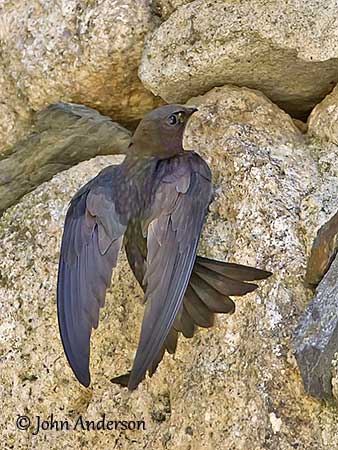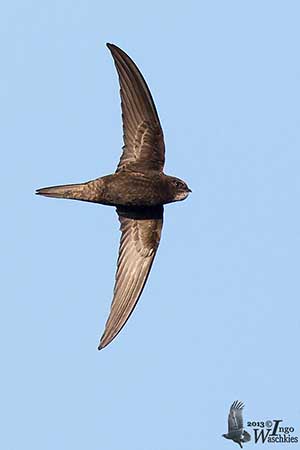
Fr: Martinet noir
Ang: Common Swift
All: Mauersegler
Esp: Vencejo Común
Ita: Rondone eurasiatico
Nd: Gierzwaluw
Sd: Tornseglare
Photographers:
John Anderson
John Anderson Photo Galleries
Jean Michel Fenerole
Photos d’Oiseaux du monde
Steve Garvie
RAINBIRDER Photo galleries & Flickr Rainbirder
Ingo Waschkies
Bird Photography
Nicole Bouglouan
PHOTOGRAPHIC RAMBLE
Text by Nicole Bouglouan
Sources:
HANDBOOK OF THE BIRDS OF THE WORLD Vol 5 by Josep del Hoyo-Andrew Elliott-Jordi Sargatal - Lynx Edicions - ISBN: 8487334253
BIRDS OF AFRICA SOUTH OF THE SAHARA by Ian Sinclair and Peter Ryan - Princeton University Press Princeton and Oxford - ISBN: 0691118159
BIRDS OF THE MIDDLE EAST by R.F. Porter, S. Christensen, P Schiermacker-Ansen C.Helm - ISBN: 0713670169
ENCYCLOPEDIE DES OISEAUX DE FRANCE ET D’EUROPE – de Peter Hayman et Rob Hume - Flammarion – ISBN : 2082009920
L’ENCYCLOPEDIE MONDIALE DES OISEAUX - Dr Christopher M. Perrins - BORDAS - ISBN: 2040185607
THE COMPLETE BOOK OF BRITISH BIRDS – Written by “Royal Society for the Protection of Birds” experts - Préface de Magnus Magnusson - Michael Cady- Rob Hume Editors - ISBN: 0749509112
THE HANDBOOK OF BIRD IDENTIFICATION FOR EUROPE AND THE WESTERN PALEARCTIC by Mark Beaman, Steve Madge - C. Helm - ISBN: 0713639601
Animal Diversity Web (University of Michigan Museum of Zoology)
Birds of Britain - The Web Magazine for Birdwatchers
Biodiversity Explorer – The Web of Life in Southern Africa
Pájaros de España (JL Beamonte)
What Bird-The ultimate Bird Guide (Mitchell Waite)
Birding Frontiers - Tracking ‘pekinensis’ Common Swifts
Common Swift
Apus apus
Apodiformes Order – Apodidae Family
INTRODUCTION:
The Common Swift spends almost its entire life in the air. It feeds, drinks, sleeps and mates while flying. It comes to land only for laying the eggs and feeding the chicks. A young bird may spend up to 3-4 years in the air, from its first flight to the return to the colony, in order to raise its own chicks.
The Common Swift is an amazing flier and flocks flying at great speed around the breeding sites are common. Their sharp calls are very distinctive. Rarely seen perched, this species is part of the sky.
DESCRIPTION OF THE BIRD:
Biometrics:
Length: 16-17 cm
Wingspan: 40-44 cm
Weight: 30-50 g
The Common Swift is a fairly large, slender swift with blackish-brown plumage overall, except the small white throat patch. On the underwing, greater coverts and inner wing are slightly paler, like rump and forehead.
In fresh plumage, the feathers are blacker with narrow white edges.
The sickle-like wings have long outer part and are strongly pointed. The long tail is deeply forked.

The small bill is black but the gape is huge. The eyes are dark brown. The short legs and the feet are well-adapted with the four strong claws used for clinging onto vertical supports such as chimneys, walls, buildings or cliffs.
Both adults are similar.
The juvenile is blacker than adults, but it shows white fringes to forehead feathers forming a small patch, whereas the white throat patch is larger and more defined.
SUBSPECIES AND RANGE:
The Common Swift has two subspecies.
A.a. apus (described above) occurs in W, N and S Europe and NW Africa, E to Lake Baikal, and SE towards Iran. It winters in Africa, from DR Congo and Tanzania, S to Zimbabwe and Mozambique.
A.a. pekinensis is found in Iran and E of Caspian Sea region, and N, C and E Afghanistan, E through W Himalayas (to C Nepal) to Mongolia and N China. It winters in E and S Africa (mainly Namibia and Botswana).
This race has paler forehead and shows greater contrast in wing.
HABITAT:
The Common Swift flies over a variety of habitats such as forests, open plains, deserts and steppes. It nests in holes in eaves, buildings, walls and occasionally cliffs, and can be seen around villages and towns with suitable nesting sites. It is recorded from sea-level to high altitudes.
The race pekinensis can be found between 1500 and 3000 metres of elevation in Himalayas, and foraging to 4000 metres. Some records of migrating birds are reported at 5700 metres in Ladakh in N India.
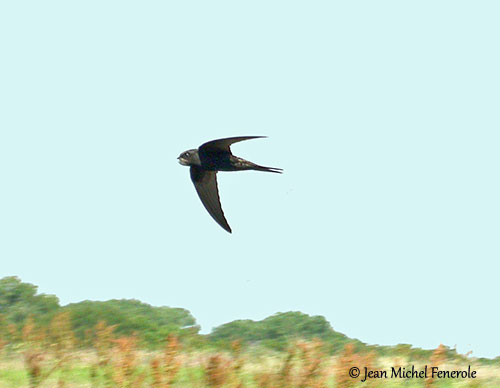
CALLS AND SONGS: SOUNDS BY XENO-CANTO
The Common Swift gives loud, shrill screams in flight “swii-rii” including the sharp “swii” of females and the louder and lower “srii” of males.
While flying in groups, the birds call together, involving a continuous, high-pitched reeling sound, often heard around buildings and monuments in towns during summer, close to the nesting colonies.
Calls of flying groups
BEHAVIOUR IN THE WILD:
The Common Swift feeds on insects caught in flight after rapid chasing in the air. The bird flies and opens widely its mouth to catch insects in the air. Various insect species are eaten such as Hymenoptera, Diptera, Hemiptera and Coleoptera. It usually avoids the stinging insects.
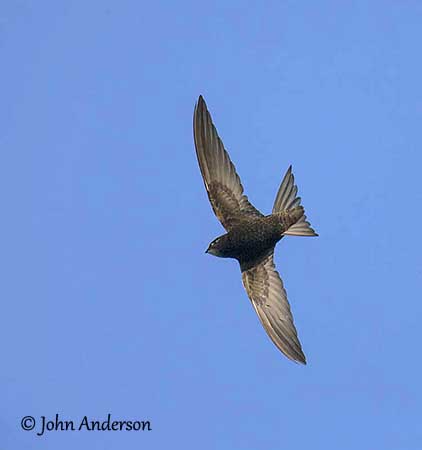
From studies of pellets, the diet includes about 300-500 prey species of up to 12 millimetres. It drinks by flying low over the water with wide open bill.
They often form large mixed-species flocks with other swifts and swallows. These flocks allow better protection against raptors which regularly take swifts. They frequently mob small raptors while giving alarm calls.
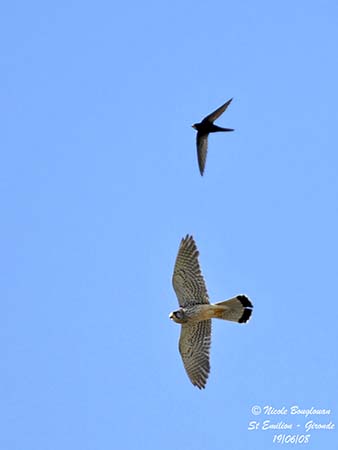
The Common Swift usually returns to the same colony each year. The pairs may breed together for many years, and they are apparently monogamous.
In cold weather, the roosting pair ruffles the feathers and arches the back, and mates often roost one on top of the other to keep warm.
During the breeding season, they perform aerial displays. The female submits by displaying the white throat patch, and they perform allopreening. The copulation takes place in the air or at nests.
The Common Swift performs aerial roosting at great heights, between 1000 and 3000 metres. They roost in flocks and initially involve screaming parties, then becoming close-circling and rapidly rising groups. The height is maintained by slow wingbeats interspersed with glides. They fly into the wind which provides lift. However, they also roost on walls or in tree hollows, or even on the outer foliage.
They form large flocks prior to migration but they often travel is smaller groups. They are long-distance migrants. They are present on their African wintering areas from September, and leave in late January/early February to return to their breeding grounds.
The race pekinensis leaves South Africa by early March.
The Common Swift is vagrant to many oceanic islands, including Prince Edward Archipelago in S Indian Ocean.
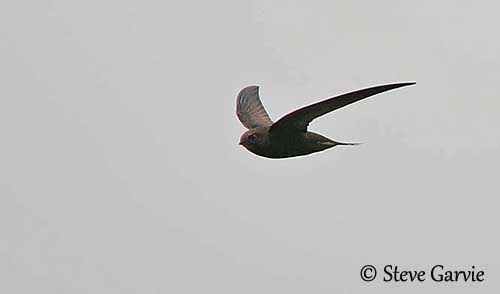
In fine weather, the Common Swift flies high in the air by circling on flicking wings and long glides, and often tilting. During fast flight, they give the illusion of beating their wings alternately. They can spend all the day in flight, illustrating both endurance and strength, and their amazing aerial ability.

REPRODUCTION OF THIS SPECIES:
The Common Swift breeds in spring, generally from March to June according to the range. It nests in colonies, but some pairs nest solitary. The nests are usually about one metre apart. The nesting site is chosen by the male and protected by both mates.
A colony may include 30 to 40 nests, and is often established in buildings, although rock crevices and tree hollows are used too outside towns and villages.
The cup-shaped nest is made with pieces of vegetation and feathers, held together with bird’s gelatinous saliva. The inner diameter of the cup is about 45 millimetres.
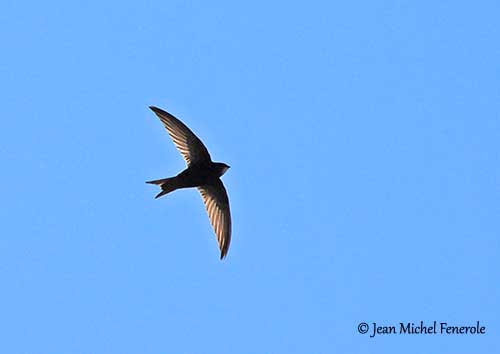
The female lays 1-4 white pear-shaped eggs. Both adults share the incubation in periods of two hours during 19-20 days. The chicks are naked at hatching and brooded continuously in first week. They have some down at 13 days, and more extensive at 17 days. They are fully feathered at one month.
The adults bring the food in the throat pouch (food-balls). About 10 food-balls are brought every day to the nest. The nestlings perform wing exercises and allopreening from 2-3 weeks of age. According to the weather conditions, they fledge between 37 and 56 days, usually about 42 days after hatching.
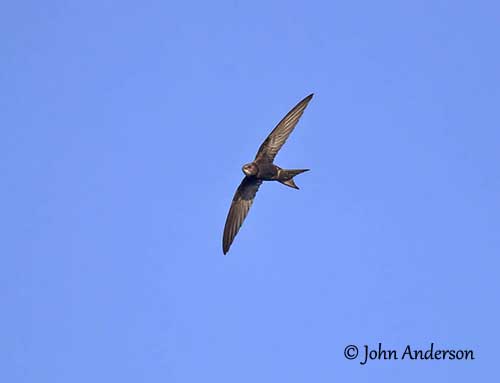
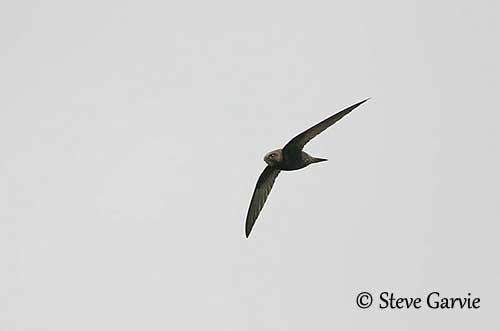
The Common Swift, both adults and young, are able to enter a state of torpor. If food sources become scarce after the young hatch, the chicks can become semi-torpid (a hibernation-like state), reducing the energy demands of their rapidly growing bodies. They may live with little food for 10-15 days.
The food-balls consist of insects gathered in the throat pouch by the adult during the flight, and held together by saliva. The chicks share a food-ball among them first, but later, each young is able to swallow an entire food-ball.
PROTECTION / THREATS / STATUS:
The Common Swift has very wide range. Some declines are reported in several countries, but the population is currently fairly stable.
In Europe, the population was estimated to number 20,700,000/51,000,000 individuals in 2004. An estimate of the global population indicates 40,000,000/200,000,000 individuals, as Europe forms 25-49% of the global population.
But currently, the Common Swift is evaluated as Least Concern.
